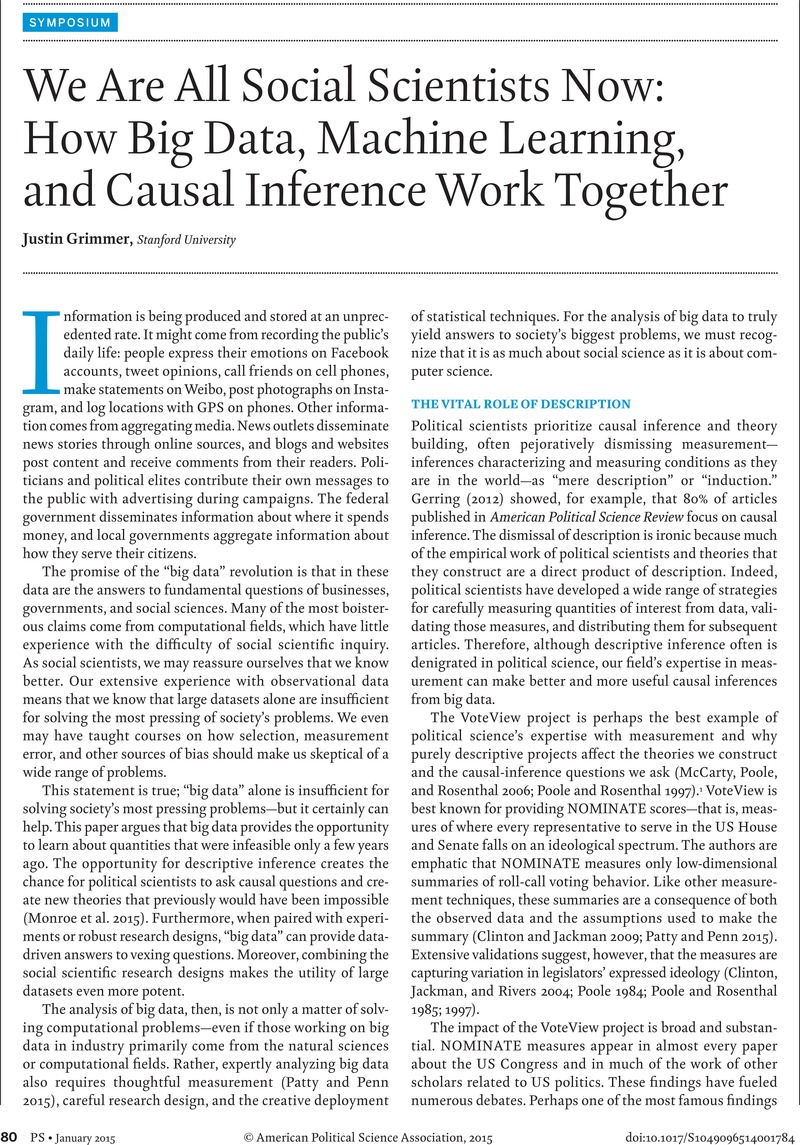Crossref Citations
This article has been cited by the following publications. This list is generated based on data provided by Crossref.
Hagen, Loni
Harrison, Teresa M.
Uzuner, Özlem
Fake, Tim
Lamanna, Dan
and
Kotfila, Christopher
2015.
Introducing textual analysis tools for policy informatics.
p.
10.
Zambom Santana, Luiz Henrique
dos Santos Mello, Ronaldo
and
Roisenberg, Mauro
2015.
Smart Crawler.
p.
125.
Peysakhovich, Alexander
and
Naecker, Jeffrey
2015.
Machine Learning and Behavioral Economics: Evaluating Models of Choice Under Risk and Ambiguity.
SSRN Electronic Journal,
Grubert, Emily
and
Siders, Anne
2016.
Benefits and applications of interdisciplinary digital tools for environmental meta-reviews and analyses.
Environmental Research Letters,
Vol. 11,
Issue. 9,
p.
093001.
London, Jennifer A.
2016.
Re-imagining the Cambridge School in the Age of Digital Humanities.
Annual Review of Political Science,
Vol. 19,
Issue. 1,
p.
351.
Fraire, Mary
Spagnuolo, Sabrina
and
Stasi, Serenella
2016.
L'utilizzo dei big social data per la ricerca sociale: il caso della cittadinanza attiva in difesa del territorio.
SOCIOLOGIA E RICERCA SOCIALE,
p.
174.
Maciejewski, Ross
and
Montgomery, Douglas C.
2016.
Visualization for Data Science: Adding Credibility, Legitimacy, and Saliency.
Big Data,
Vol. 4,
Issue. 2,
p.
73.
Katz, Gabriel
and
Levin, Ines
2017.
Varieties of Political Support in Emerging Democracies: A Cross-National Analysis.
SSRN Electronic Journal,
Laaksonen, Salla-Maaria
Nelimarkka, Matti
Tuokko, Mari
Marttila, Mari
Kekkonen, Arto
and
Villi, Mikko
2017.
Working the fields of big data: Using big-data-augmented online ethnography to study candidate–candidate interaction at election time.
Journal of Information Technology & Politics,
Vol. 14,
Issue. 2,
p.
110.
Bauer, Paul C.
2017.
Visualizing Causal Scenarios [Interactively].
SSRN Electronic Journal ,
Yang, Chaowei
Huang, Qunying
Li, Zhenlong
Liu, Kai
and
Hu, Fei
2017.
Big Data and cloud computing: innovation opportunities and challenges.
International Journal of Digital Earth,
Vol. 10,
Issue. 1,
p.
13.
Dourado, Aloisio
Carvalho, Rommel N.
and
van Erven, Gustavo C. G.
2017.
Brazil's Bolsa Familia and young adult workers: A parallel RDD approach to large datasets.
p.
17.
Donohoe, Terry
Garnett, Kenisha
Lansink, Alfons Oude
Afonso, Ana
and
Noteborn, Hubert
2018.
Emerging risks identification on food and feed – EFSA.
EFSA Journal,
Vol. 16,
Issue. 7,
Dong, Dapeng
and
Herbert, John
2018.
Content-Aware Partial Compression for Textual Big Data Analysis in Hadoop.
IEEE Transactions on Big Data,
Vol. 4,
Issue. 4,
p.
459.
Katz, Gabriel
and
Levin, Ines
2018.
Varieties of political support in emerging democracies: A cross-national analysis.
Social Science Research,
Vol. 70,
Issue. ,
p.
55.
Takahashi, Yoshiko
and
Evans, Len T.
2018.
An Application of Machine Learning for Predicting Rearrests: Significant Predictors for Juveniles.
Race and Social Problems,
Vol. 10,
Issue. 1,
p.
42.
Comarela, Giovanni
Durairajan, Ramakrishnan
Barford, Paul
Christenson, Dino
and
Crovella, Mark
2018.
Assessing Candidate Preference through Web Browsing History.
p.
158.
Creamer, Germán G.
Ghoddusi, Hamed
and
Rafizadeh, Nima
2018.
Machine Learning in Energy Economics and Finance: A Review.
SSRN Electronic Journal ,
Cariceo, Oscar
Nair, Murali
and
Lytton, Jay
2018.
Data science for social work practice.
Methodological Innovations,
Vol. 11,
Issue. 3,
p.
205979911881439.
Mijares, Víctor M.
2018.
Performance of the South American Defense Council Under Autonomy Pressures.
Latin American Policy,
Vol. 9,
Issue. 2,
p.
258.





